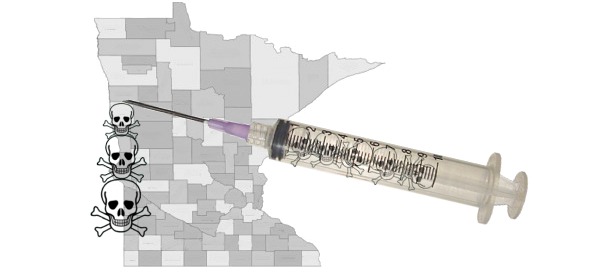Featured
Tightly Wound DNA in Schizophrenic Brains? It’s the Researchers Who are Too Tightly Wound

I Want to Scream, by superb artist and homeopath Gina Tyler (Cropped and with original words in graphic removed for use here.) Graphic is a link to Gina's website.
This is an “I want to scream!” topic. Yet again, a study has been produced claiming to show that the brains of schizophrenics are different. And yet again, nothing of the sort is demonstrated. What is particularly disturbing is the brazenness of the study’s flaw. While I don’t like to make accusations, it’s hard to believe that the authors could possibly be unaware of it. The flaw is so serious that, even if the data they produced is correct, it still demonstrates nothing about the inherent nature of schizophrenic brains.
The Study
The study, titled “Disease- and age-related changes in histone acetylation at gene promoters in psychiatric disorders“, was published in the journal Translational Psychiatry, which is produced by Nature. The researchers dissected and tested the brains of 66 people from two different sources. From the Harvard Brain Tissue Resource Center, they examined the brains of 50 subjects:
- 18 defined as normal
- 16 defined as schizophrenic
- 16 defined as bipolar
From the Victorian Brain Bank Network, they examined 16 brains:
- 8 defined as normal
- 8 defined as schizophrenic
Epigenetic changes are differences in gene functioning that are unrelated to changes in the DNA sequence. That is, epigenetic changes refer to a difference like change of shape or rate of activity, in spite of there being no change in the DNA code itself. The researchers believe that they found epigenetic changes in schizophrenic brains. They are related to histones, tiny bits of protein that DNA must wrap around to unravel itself for action in controlling cellular function. If the histones are, effectively, too active, then the DNA cannot unravel to initiate cellular function. These changes affect how tightly wound the DNA strand is. If the DNA doesn’t relax enough—that is, if it doesn’t become unwound—it cannot make the chemical connections required to issue instructions to the cell. Therefore, according to this research, the DNA of schizophrenics is too tightly wound.
The Gaping Flaw
So what’s wrong with the study? If the results are legitimate, if the researchers did show that the brains of schizophrenics are, indeed, different, then where’s the error? In today’s world, nearly all people who have been labeled as schizophrenic are given antipsychotics. It’s standard operating procedure. The question isn’t whether they’ll be given these drugs; it’s which drug they’ll be given. Therefore, the likelihood that anyone who carries the diagnosis of schizophrenia hasn’t taken these drugs is close to zero. Yet, the authors of this study didn’t even take that into account! Antipsychotics are known to cause severe brain damage. They function by producing brain damage. Therefore, if the researchers don’t even consider whether the people whose brains they’re studying were being drugged, how can they possibly determine that there is an inherent difference in their brains? The answer is, of course, that they cannot. This study has uncovered one thing, and one thing only: The drugs given to people diagnosed as schizophrenic cause brain damage.Why would scientists do such an absurd study? Why would they come to the absurd conclusion that schizophrenic brains are inherently flawed?
What’s the Purpose of Such an Absurd Study?
As always, one need only look for the money trail. In this case, it’s easy to find. As quoted in PsychCentral’s article, “Tightly Wound DNA in Brain Tied to Schizophrenia“, lead researcher Professor Elizabeth Thomas stated:
We’re excited by the findings, and there’s a tie to other drug development work, which could mean a faster track to clinical trials to exploit what we’ve found.
We need search no further. The research purported to find that histones, small proteins involved in the unwrapping of DNA to activate cellular functions, are overactive. Therefore—according to the study—the DNA is, effectively, too tightly wrapped because the overactive histones won’t let it unravel. That’s where the class of drugs, histone deacetylase inhibitors (HDIs), come in. As their name suggests, they inhibit the activity of histones And that, of course, was the real goal of the study: to lend credence to the idea that HDI drugs may benefit schizophrenic patients. Is it any wonder that the lead researcher, Elizabeth Thomas, wondered if the brains of schizophrenics would show such a change in histone activity?
The Truly Revealing Element of This Tale
It sounds like a new class of drugs has been discovered, that HDIs may be the wave of the future for antipsychotic drugs. The truth, though, is truly pathetic. These drugs are among the oldest class used in treating schizophrenia. Need I point out that their effectiveness is known to be exceedingly poor?
The primary drug of this classification is valproic acid, which is sold under the brand names of Depakote, Depakene, Depacon, Depakine, Valparin, and Stavzor. It’s a particularly old drug, first synthesized in 1882. (No, that isn’t a typo. It’s 18, not 19, 82.) What’s clear is that Big Pharma has few or no new drugs in the pipeline for the treatment of so-called mental illness. Therefore, they’re trying—desperately, and one can hope, ineffectually—to recycle old drugs known to be useless and harmful as something new. Because that’s what valproic acid is, an HDI—an old, known to be useless, drug.
Good News, Bad News
Good News The good news is, of course, that it looks like Big Pharma may be reaching the end of the trail. New drugs are few and far between. The uselessness and horrific adverse effects are now well documented. We can hope that the story stops here. Bad News However, Big Pharma is clearly not giving up. Though the study documented here wasn’t funded by them directly, there is obviously only one reason for its existence—to lend credence to a new push for use of an old drug. The next step, you can be sure, is to demonstrate, somehow through pseudo science like this study, that there’s something new and unique about applying valproic acid to schizophrenics. If that can be accomplished, it will likely be patented all over again. And that, of course, is clearly the goal. Starting with this study, valproic acid will be hyped as if it were a new drug with a whole new action that will now, finally, provide the relief that so many “desperate” and “needy” schizophrenics desperately need. It will be promoted as a new discovery, one that will turn lives around. It will, of course, be a lie—just like every other antipsychotic drug has proven to be, and this one already has. This is the state of modern medicine and its pharmaceutical drugs. It’s based on lies, and supported by nonexistent evidence-based medicine that’s built on pseudo science.
- Big Pharma uses even more absurd pseudo science in a pathetic attempt to bring known-ineffective old drugs back to the market because there aren’t any new ones in the pipeline to take their place.
- So, researchers take heed and provide yet more pseudo science to support what Big Pharma is clearly hoping will prove to be a cycle of resurrecting useless old drugs as if they were new.
Either we’re in Big Pharma’s unsuccessful end-game, or we’re in the beginning of a new cycle of ineffective and devastating drugs.
Tagged big pharma drugs, big pharma pseudo science, big pharma schizophrenia, conventional medicine, histones schizophrenia, histones tightly wound dna, modern medicine, modern medicine big pharma, modern medicine pseudo science, normal brains schizophrenic brains, pharmaceutical drugs, pharmaceuticals, pseudo science schizophrenia, pseudo-science, pseudoscience, psychiatry, schizophrenia, schizophrenia pseudo science, schizophrenia tightly wound dna, schizophrenia valproic acid, schizophrenic brains, schizphrenia histones, science, tightly wound dna, tightly wound dna schizophrenia














